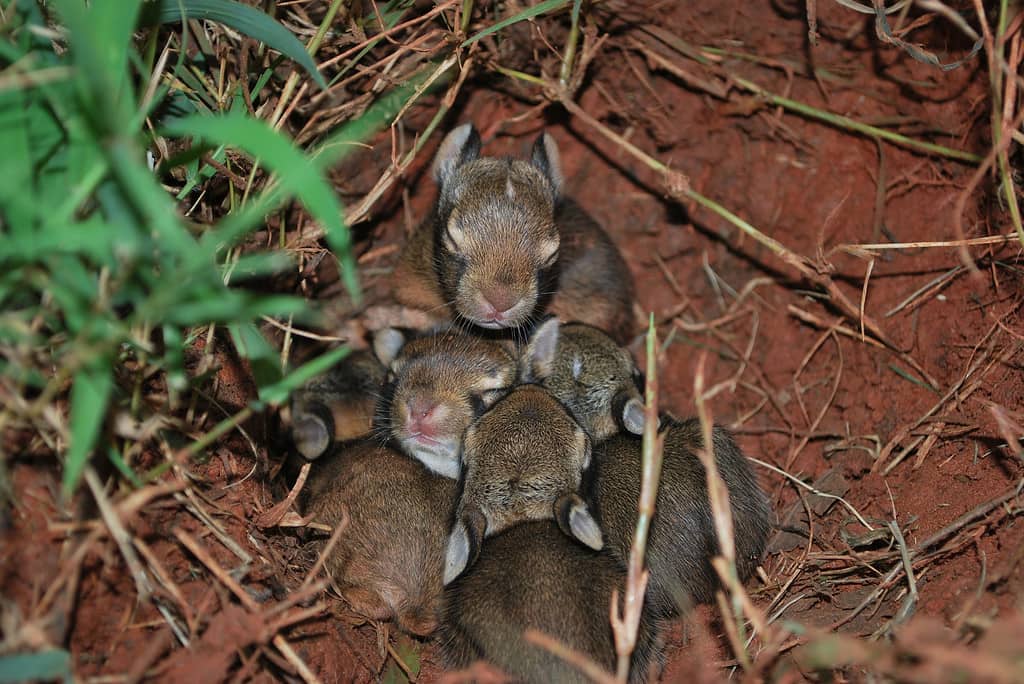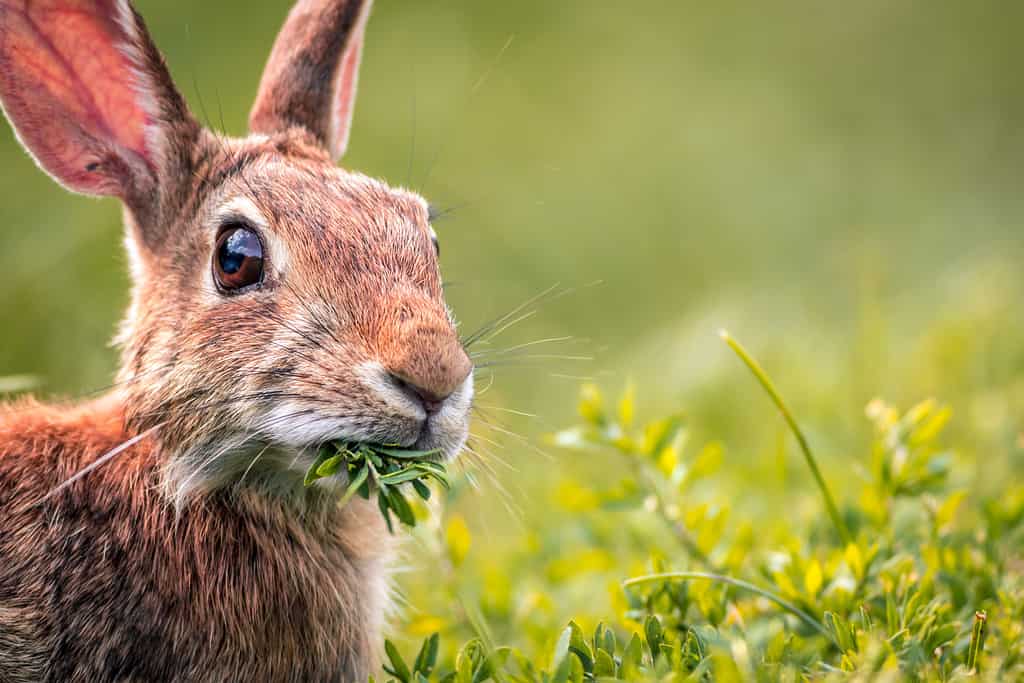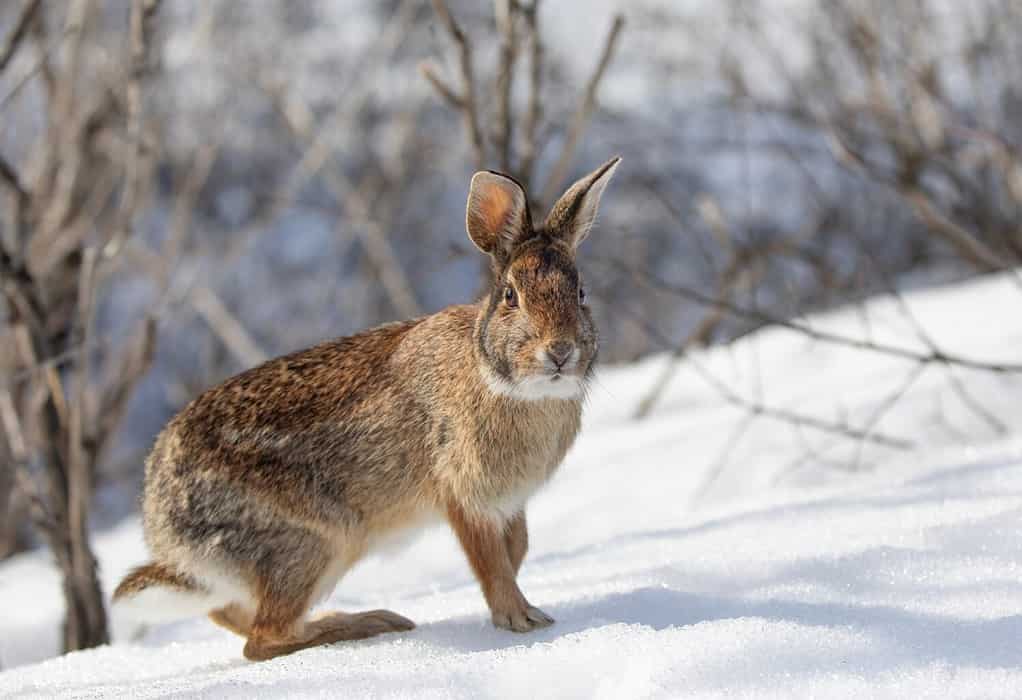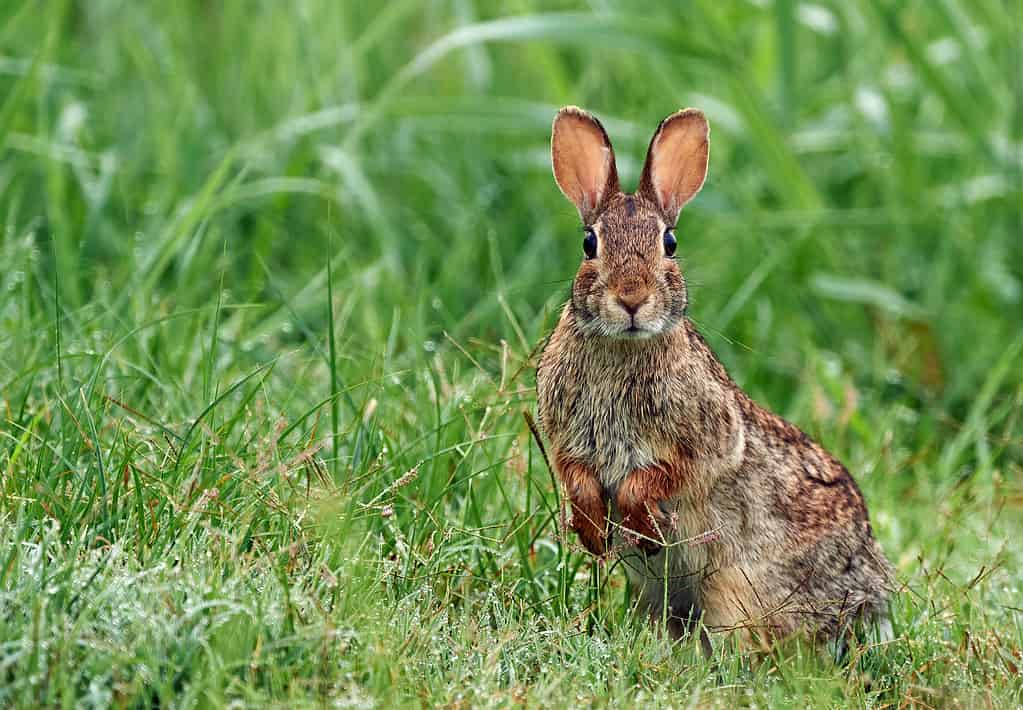The eastern cottontail is a common sight in meadows, fields, and suburban yards across most of the country. Eastern cottontails (Sylvilagus floridanus) are found throughout the United States east of the Rocky Mountains and down into Central America and northern South America. These rabbits are so common that it begs the question, how long do they live? Let’s take a look at the eastern cottontail’s lifespan, life stages, and how they compare to other animals.
Cottontail Life Stages

Baby cottontails open their eyes at around seven days old.
©shanelinkcom/iStock via Getty Images
The saying “breeding like rabbits” is an apt one. One reason there are so many cottontails is that they are incredibly prolific breeders. Unlike many other mammals, baby season isn’t limited to springtime for cottontails. Female rabbits (called does) go into heat in late February and do so repeatedly until fall. During this time, they average around three to five litters, though some cottontails will breed up to seven times per year.
And these rabbits start breeding early. Does go into their first heat at just three months old. This means that cottontails born in the spring are potentially reproducing by fall, though many do not breed until the following spring. Cottontail pregnancies last 28 days, and mothers can become pregnant again almost immediately after giving birth and while they are still nursing their previous litter.
The average litter size for cottontails varies anywhere between one and 12 babies (called kits), with most litters averaging between four and eight kits. Kits are born hairless and with their eyes and ears sealed shut. However, these animals grow fast: Kits open their eyes at seven days old, wean at 16-21 days, and are out of the nest at around three weeks of age. By four weeks old, they are completely independent.
When kits are still in the nest, the mother does not remain with their babies all of the time. Instead, she only visits the nest at dusk and dawn to nurse and clean the kits. By staying away from the nest during the day and night, the mother avoids attracting predators to the location.
Once they leave the nest, the kits do not stick with their siblings or mother but strike out independently. Around the time the babies become completely independent, the doe may give birth again. Because they can give birth so frequently, a fertile doe could have up to 70 babies per season.
Eastern Cottontail Lifespan

Eastern cottontails have excellent 360-degree vision, with the exception of a small blind spot in front.
©Rabbitti/Shutterstock.com
Cottontails need to have dozens of babies to keep the population stable because they do not live very long. Kits are incredibly vulnerable and susceptible to predation, and only 44% of cottontails live past their first month. Few survive to breeding age themselves, as only around 25% live for a year after birth.
The average lifespan for cottontails that do make it out of the nest is around 11 months, though there are reports of wild rabbits living as long as five years. In captivity, cottontails can reach nine to 10 years of age.
Why Don’t They Live Longer?

Cottontails do not hibernate but instead ride out the winter on a diet of bark, tree buds, and twigs.
©Jim Cumming/Shutterstock.com
For animals at the bottom of the food chain like cottontails, life can be a tough — and short —ride. Wild rabbits have short lifespans because they are a food source for almost all predators including coyotes, hawks, owls, bobcats, rattlesnakes, foxes, and raccoons.
Cottontails are also hunted for their meat and fur, and rabbits are one of the most popular small game animals to hunt. While rabbit hunting has declined since the early 20th century, approximately 1.5 million people report rabbit hunting each year. Other human-based dangers to cottontails include vehicular trauma, poisoning, and habitat destruction.
Rabbits also face threats from domestic animals such as cats and dogs. According to recent research, domestic cats kill between 6.9 billion and 20.7 billion small animals a year worldwide. While not all of the animals killed are cottontails, young rabbits are especially susceptible to cat attacks since their nests are often in suburban yards and gardens. Dogs also pose a threat to rabbits, as their superior sense of smell can often sniff out cottontail nests. All of these dangers drastically reduce the average eastern cottontail lifespan.
Eastern Cottontail Lifespan Compared to Other Animals

Female cottontails have an average range of 1.2 acres, while the male’s range can be up to 10 acres.
©ArCaLu/Shutterstock.com
Eastern cottontails have short lifespans even compared to other prey animals. Squirrels, chipmunks, and hares all live longer than cottontails. Because these animals live longer, they do not need to breed as rapidly as rabbits, as the population will remain stable without huge influxes of babies.
| Animal | Lifespan | Gestation | Litter Size | Litters Per Year |
|---|---|---|---|---|
| Eastern cottontail | 1-2 years | 28 days | 1-12 | 3-7 |
| Fox squirrel | 6-7 years | 44 days | 2-5 | 1-2 |
| Eastern chipmunk | 2-7 years | 31 days | 2-6 | 1-2 |
| Brown hare | 3-4 years | 42-44 days | 2-4 | 3-4 |
The photo featured at the top of this post is © Rabbitti/Shutterstock.com
Thank you for reading! Have some feedback for us? Contact the AZ Animals editorial team.






